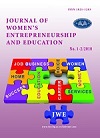Pandita Ramabai Saraswathi: Making of a Social Entrepreneur
Main Article Content
Abstract
After the ingress of imperialism through colonization, Indian society underwent transition. Transition to modernity though opened up new avenues for the middle class women by enabling them to opt for English education and selective participation in the public sphere, there was hardly any escape from the broader patriarchal and caste dominated social design. An exploration into the social history of the 19th century India unfolds the intricate designs within the nation’s social fabric. The process of modernization opened new opportunities to the educated Indian men especially drawn from the dominant castes. These opportunities were in the form of ascribed status created at the bottom of the pyramids of power structure. Changing positions of men in the process of modernization called for realignment in the role of women within the family and society. These new roles for women necessitated the acquisition of certain skills, which was readily provided to them through English education. This also opened up a little space for women, which was not available to them in the system that prevailed till then. Pandita Ramabai Saraswathi was able to appropriate this little space that was opened for women. She had an in depth knowledge of the Hindu Religion, the gap between the practice and its philosophy, as reflected by the condition of women in the Indian society. Ramabai stands apart from many of her contemporaries, in a number of ways. This is the reason why, we choose to consider her a social entrepreneur of the period in which she lived. Accordingly, the term social entrepreneur is used to signify the leadership taken by Ramabai, the courage she has shown to accept the challenge, the manner in which she organized her whole project, and addressed the social problems confronted by women of her caste. Therefore, it was thought necessary to contextualize the situation within which Ramabai was driven towards the achievement of a social goal. The term social entrepreneur is of recent origin but the spirit of social enterprise is not new. It is not easy to frame a definition that would encompass the varied entrepreneurial ventures undertaken to achieve a social goal all over the world. It has to be understood as a particular concept constructed within a particular context. Even though the concept of social entrepreneur is mostly in circulation in the capitalist economy, it embodies features that are quite distinct from the reformers and business entrepreneurs. The paper attempts to make a contextualized space-time study of Ramabai as a social entrepreneur.
Article Details
Section
Once the manuscript is accepted for publication, authors shall transfer the copyright to the publisher. If the submitted manuscript is not accepted for printing by the journal, the authors shall retain all their rights. The following rights on the manuscript are transferred to the publisher, including any supplementary materials and any parts, extracts or elements of the manuscript:
- the right to reproduce and distribute the manuscript in printed form, including print-on-demand;
- the right to print prepublications, reprints and special editions of the manuscript;
- the right to translate the manuscript into other languages;
- the right to reproduce the manuscript using photomechanical or similar means including, but not limited to photocopy, and the right to distribute these copies;
- the right to reproduce and distribute the manuscript electronically or optically using and all data carriers or storage media, and especially in machine readable/digitalized form on data carriers such as hard drive, CD-ROM, DVD, Blu-ray Disc (BD), Mini Disc, data tapes, and the right to reproduce and distribute the article via these data carriers;
- the right to store the manuscript in databases, including online databases, as well as the right to transmit the manuscript in all technical systems and modes;
- the right to make the manuscript available to the public or to closed user groups on individual demand, for use on monitors or other readers (including e-books), and in printable form for the user, either via the Internet, online service, or via internal or external networks.
Authors reserve the copyright to published articles and have the right to use the article in the same manner like third parties in accordance with the licence Attribution-Non-Commercial-Non-Derivate 4.0 International (CC BY NC ND). Thereby they must quote the basic bibliographic data of the source article published in the journal (authors, article title, journal title, volume, pagination).
